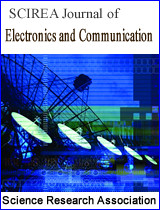Multipulse Heterogeneous Analysis of CA_GTM Adaptive Scheme for Fluctuating Radar Targets
DOI: 395 Downloads 4163 Views
Author(s)
Abstract
To mitigate the deleterious effects of clutter and jammer, modern radar have adopted adaptive processing techniques such as CFAR detectors. The aim of these processors is to automatically detect targets in the case where the clutter environment is partially unknown and/or has varying statistical properties maintaining the rate of false alarm at fixed low level. The CA scheme has an optimum detection performance among the mean level CFAR family in the case of homogeneous noise when the neighboring reference cells of sliding window contain the noise data obeying the same PDF and having the same statistical parameters as the data stored in the test cell of sliding window. However, the reference cells are often contaminated by power variations over range, clutter discretes, and other outliers. Additionally, the strength of the clutter also fluctuates with terrain type, elevation, ground cover and the presence of man-made structures. In these situations, the estimating cells may not be representative of the disturbance in the test cell and the CA exhibits strong degradations both in the detection performance as well as in the CFAR behavior. In the real world, still sub-optimal performance might occur (high false alarm rate and/or low detection probability) as a consequence of heterogeneous clutter, dense target backgrounds, and large discrete and spiky clutter. Therefore, the heterogeneous improvement possibility of this algorithm is of primary concern. This paper is devoted to the analysis of a sophisticated version, which is a combination of CA and GTM, of CFAR schemes collecting data from M-pulses and operating in multitarget environment to detect fluctuating targets of χ2-distribution with two-degrees of freedom. This version optimizes good features of the well-known CFAR detectors with the goal of enhancing the detection probability and keeping the false alarm rate unchanged. Our numerical results are focused on the important SWI & SWII models because of the prevalence of frequency diversity between noncoherent pulse bursts. In the presence of postdetection integration of M-pulses, it is found that the homogeneous performance of the novel version surpasses that of the fixed-threshold scheme especially for targets obeying SWII model in their fluctuations.
Keywords
Adaptive detection, noise and clutter, CA_GTM-CFAR algorithm, postdetection integration, target fluctuation models, multitarget environments
Cite this paper
Mohamed B. El_Mashade,
Multipulse Heterogeneous Analysis of CA_GTM Adaptive Scheme for Fluctuating Radar Targets
, SCIREA Journal of Electrics, Communication.
Volume 1, Issue 1, October 2016 | PP. 15-48.
References
| [ 1 ] | W. Q. Wang (2013), “Radar Systems: Technology, Principals and Applications”, Nova Science Publishers, Inc, 2013. |
| [ 2 ] | El Mashade, M. B. (1994), “M-sweeps detection analysis of cell-averaging CFAR processors in multiple target situations”, IEE Radar, Sonar Navig., Vol.141, No.2, (April 1994), pp. 103-108. |
| [ 3 ] | El Mashade, M. B. (2006), "Analysis of Cell-Averaging Based Detectors for χ2 Fluctuating Targets in Multitarget Environments", Journal of Electronics (China), Vol.23, No.6, (November 2006), pp. 853-863. |
| [ 4 ] | El Mashade, M. B. (2008), “Performance Analysis of OS Structure of CFAR Detectors in Fluctuating Target Environments”,Progress In Electromagnetics Research C, Vol. 2, pp. 127-158, 2008 |
| [ 5 ] | Dejan Ivković, Milenko Andrić and Bojan Zrnić (2014),"False Alarm Analysis of the CATM-CFAR in Presence of Clutter Edge", Radioengineering, Vol. 23, No. 1, April 2014, pp.66-72. |
| [ 6 ] | El Mashade, M. B. (2013), "Analytical Performance Evaluation of Adaptive Detection of Fluctuating Radar Targets", Radioelectronics and Communications Systems, 2013, Vol. 56, No. 7, pp. 321–334. |
| [ 7 ] | Dejan Ivković, Milenko Andrić and Bojan Zrnić (2014), "A New Model of CFAR Detector", Frequenz 2014; 68(3–4): 125 – 136. |
| [ 8 ] | El Mashade, M. B. (2015), “Adaptive Detection Enhancement of Partially-Correlated χ2 Targets in an Environment of Saturated Interference”,Recent Advances in Electrical & Electronic Engineering, Volume 8, 2015. |
| [ 9 ] | S. W. Hong and D. S. Han (2014), "Performance Analysis of an Environmental Adaptive CFAR Detector", Hindawi Publishing Corporation Mathematical Problems in Engineering Vol. 2014, pp. 1-7. |
| [ 10 ] | El Mashade, M. B. (2001), "Postdetection integration analysis of the excision CFAR radar target detection technique in homogeneous and nonhomogeneous environments", Signal Processing “ELSEVIER”, Vol. 81 (2001), pp.2267–2284. |
| [ 11 ] | F. J. Jen, M. Gialich, B. Lambrecht, Z. Aliyazicioglu, H. K. Hwang (2012), "Performance Analysis of a new CFAR Algorithm under Heterogeneous Environments", Proc. of Int. Conf. on Advances in Signal Processing and Communication 2012 ACEEE, pp.107-110. |
| [ 12 ] | El Mashade, M. B. (2013), "Postdetection Integration Analysis of Adaptive Detection of Partially-Correlated χ2 Targets in The Presence of Interferers", Majlesi Journal of Electrical Engineering, Vol. 7, No. 3, September 2013, pp. 43-58. |
| [ 13 ] | El Mashade, M. B. (1998), “Multipulse analysis of the generalized trimmed mean CFAR detector in nonhomogeneous background environments”, AEU, Vol.52, No.4, (Aug. 1998), pp. 249-260. |
| [ 14 ] | El Mashade, M. B. (2016), “Heterogeneous Performance Evaluation of Sophisticated Versions of CFAR Detection Schemes ”, Accepted for Publication in Radioelectronics and Communications Systems. |

